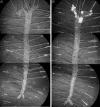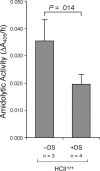Accelerated atherogenesis and neointima formation in heparin cofactor II deficient mice
- PMID: 17878401
- PMCID: PMC2234791
- DOI: 10.1182/blood-2007-04-086611
Accelerated atherogenesis and neointima formation in heparin cofactor II deficient mice
Abstract
Heparin cofactor II (HCII) is a plasma protein that inhibits thrombin when bound to dermatan sulfate or heparin. HCII-deficient mice are viable and fertile but rapidly develop thrombosis of the carotid artery after endothelial injury. We now report the effects of HCII deficiency on atherogenesis and neointima formation. HCII-null or wild-type mice, both on an apolipoprotein E-null background, were fed an atherogenic diet for 12 weeks. HCII-null mice developed plaque areas in the aortic arch approximately 64% larger than wild-type mice despite having similar plasma lipid and glucose levels. Neointima formation was induced by mechanical dilation of the common carotid artery. Thrombin activity, determined by hirudin binding or chromogenic substrate hydrolysis within 1 hour after injury, was higher in the arterial walls of HCII-null mice than in wild-type mice. After 3 weeks, the median neointimal area was 2- to 3-fold greater in HCII-null than in wild-type mice. Dermatan sulfate administered intravenously within 48 hours after injury inhibited neointima formation in wild-type mice but had no effect in HCII-null mice. Heparin did not inhibit neointima formation. We conclude that HCII deficiency promotes atherogenesis and neointima formation and that treatment with dermatan sulfate reduces neointima formation in an HCII-dependent manner.
Figures







Similar articles
-
Antithrombotic activity of dermatan sulfate in heparin cofactor II-deficient mice.Blood. 2004 Dec 15;104(13):3965-70. doi: 10.1182/blood-2004-02-0598. Epub 2004 Aug 17. Blood. 2004. PMID: 15315969
-
Heparin cofactor II modulates the response to vascular injury.Arterioscler Thromb Vasc Biol. 2007 Mar;27(3):454-60. doi: 10.1161/01.ATV.0000256471.22437.88. Epub 2006 Dec 28. Arterioscler Thromb Vasc Biol. 2007. PMID: 17194895 Review.
-
Vascular dermatan sulfate and heparin cofactor II.Prog Mol Biol Transl Sci. 2010;93:351-72. doi: 10.1016/S1877-1173(10)93015-9. Prog Mol Biol Transl Sci. 2010. PMID: 20807652 Review.
-
Comparison of heparin- and dermatan sulfate-mediated catalysis of thrombin inactivation by heparin cofactor II.J Biol Chem. 1999 Sep 24;274(39):27597-604. doi: 10.1074/jbc.274.39.27597. J Biol Chem. 1999. PMID: 10488098
-
Vascular dermatan sulfate regulates the antithrombotic activity of heparin cofactor II.Blood. 2008 Apr 15;111(8):4118-25. doi: 10.1182/blood-2007-12-127928. Epub 2008 Feb 15. Blood. 2008. PMID: 18281504 Free PMC article.
Cited by
-
Thrombin generation and atherosclerosis.J Thromb Thrombolysis. 2014 Jan;37(1):45-55. doi: 10.1007/s11239-013-1026-5. J Thromb Thrombolysis. 2014. PMID: 24241912 Review.
-
PAR2 (Protease-Activated Receptor 2) Deficiency Attenuates Atherosclerosis in Mice.Arterioscler Thromb Vasc Biol. 2018 Jun;38(6):1271-1282. doi: 10.1161/ATVBAHA.117.310082. Epub 2018 Mar 29. Arterioscler Thromb Vasc Biol. 2018. PMID: 29599135 Free PMC article.
-
Genetic and pharmacological modifications of thrombin formation in apolipoprotein e-deficient mice determine atherosclerosis severity and atherothrombosis onset in a neutrophil-dependent manner.PLoS One. 2013;8(2):e55784. doi: 10.1371/journal.pone.0055784. Epub 2013 Feb 7. PLoS One. 2013. PMID: 23409043 Free PMC article.
-
RNAi targeting heparin cofactor II promotes hemostasis in hemophilia A.Mol Ther Nucleic Acids. 2021 Apr 3;24:658-668. doi: 10.1016/j.omtn.2021.03.022. eCollection 2021 Jun 4. Mol Ther Nucleic Acids. 2021. PMID: 33996250 Free PMC article.
-
Combined life-threatening thromboses and hemorrhages in a patient with afibrinogenemia and antithrombin deficiency.Thromb J. 2018 Apr 4;16:6. doi: 10.1186/s12959-018-0162-8. eCollection 2018. Thromb J. 2018. PMID: 29636644 Free PMC article.
References
-
- Libby P. Inflammation in atherosclerosis. Nature. 2002;420:868–874. - PubMed
-
- Tracy RP. Thrombin, inflammation, and cardiovascular disease: an epidemiologic perspective. Chest. 2003;124:49S–57S. - PubMed
-
- Coughlin SR. Protease-activated receptors in the cardiovascular system. Cold Spring Harb Symp Quant Biol. 2002;67:197–208. - PubMed
-
- Farb A, Sangiorgi G, Carter AJ, et al. Pathology of acute and chronic coronary stenting in humans. Circulation. 1999;99:44–52. - PubMed
-
- Marmur JD, Thiruvikraman SV, Fyfe BS, et al. Identification of active tissue factor in human coronary atheroma. Circulation. 1996;94:1226–1232. - PubMed
Publication types
MeSH terms
Substances
Grants and funding
LinkOut - more resources
Full Text Sources
Other Literature Sources
Medical
Molecular Biology Databases

